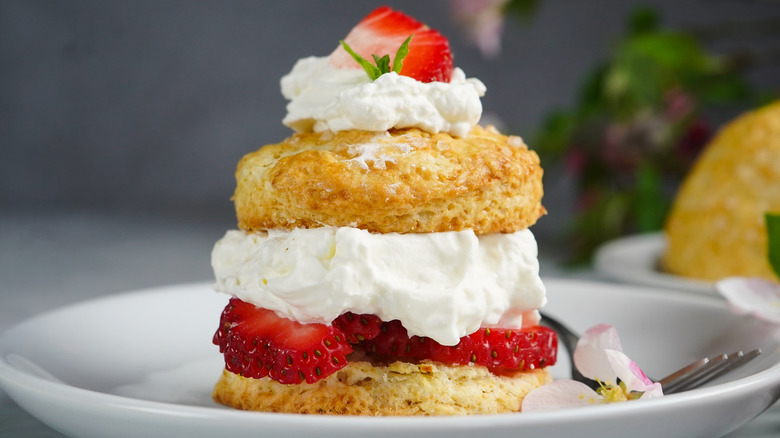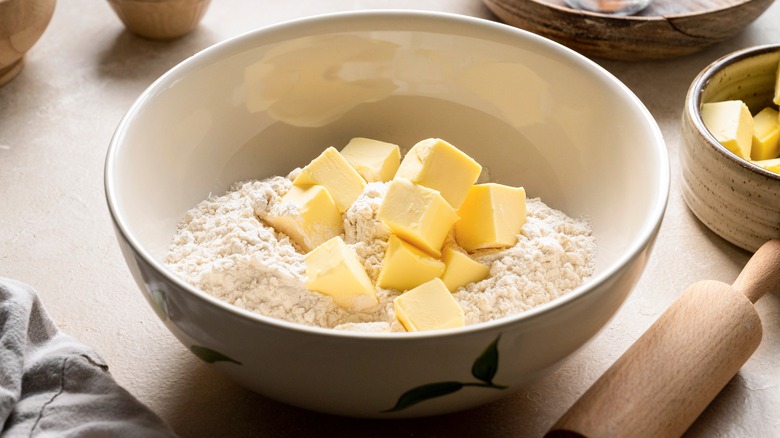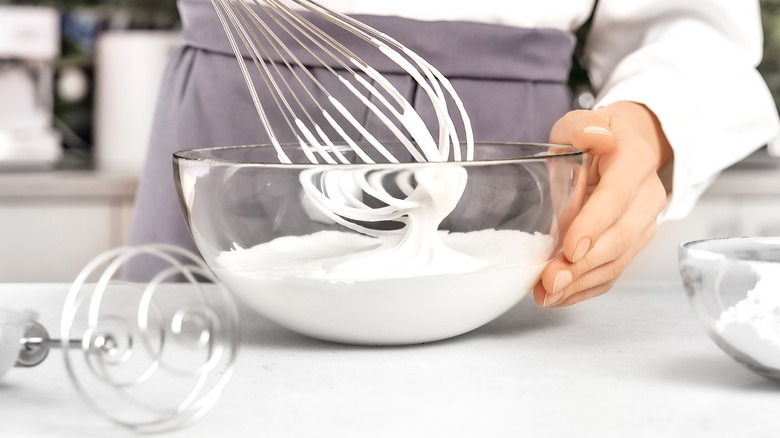The Biggest Mistake You Should Avoid When Making Strawberry Shortcake
Sometimes, the best desserts are made from the simplest ingredients. Strawberry shortcake is one of those desserts, usually assembled from just biscuits, whipped cream, and a sugared strawberry-mixture. When done right, the flavorful combination is light, fresh, and decadent, all at the same time.
When it's peak strawberry season between April and July, it's an excellent time to try making a strawberry shortcake recipe, whether you are a novice or an experienced baker. "There's a kind of magic in a summer recipe that you can make wherever you are, provided that wherever you are has, say, flour, butter, an oven, and whatever fruit is most glorious ... at that very moment," Nancy Harmon Jenkins writes in her strawberry shortcake recipe for New York Times Cooking.
Don't let the simplicity of ingredients and assembly lure you into a false sense of security, because there certainly are ways that one can go wrong when making strawberry shortcake. The biggest pitfall to avoid? Using room-temp or warm ingredients when making your biscuits.
Why you need to keep ingredients cold
When making the biscuits for strawberry shortcake, your ingredients should be fresh-out-of-the-fridge cold. Otherwise, your biscuits could end up flat, dense, or overcooked. Biscuits are typically made by combining dry ingredients (flour, sugar, salt, and baking powder) with wet ingredients (butter and milk — usually buttermilk, whole milk, heavy cream, or some combination). It is those wet ingredients that need to stay cold.
Excellent biscuits are flaky and layered, an effect achieved by a method called laminating, which involves folding the dough over itself several times. "With biscuits, you want a layered, flaky dough. Keep everything cold, and add some folds," pastry chef Penny Stankiewicz says via Kitchn. "I like to grate the cold butter, toss it with the flour to coat it, then add in the buttermilk, and toss it together by hand." If the butter and liquid are warm or room-temperature, those layers won't form as easily, and the ingredients will melt together, resulting in a dense final product. It is important that chunks of butter remain intact in the batter, since those chunks give off steam during the baking process and create pockets of air in the biscuit.
Some bakers even recommend freezing the butter to ensure it is as cold as possible. Once it is time to add butter to the dry ingredients, use a cheese grater to break up the frozen butter.
Strawberries and whipped cream are just as important
Ensuring that you have the perfect biscuit-base for your strawberry shortcake is arguably one of the most important elements of making the dessert from scratch. However, there are some other potential pitfalls to be cautious of, as well, when making the strawberry and whipped cream elements of a strawberry shortcake. First, ensure you have good-quality strawberries. There is a major difference between fresh, in-season strawberries and a dull, soggy batch. Even the sugar in strawberry shortcake won't make up for the subpar flavor of an out-of-season strawberry, so make sure you are working with the best of the best.
As for the whipped cream, making your own from scratch can be much tastier than what comes out of a spray can; just be careful not to overwhip the cream. Whipped cream is usually made by beating heavy cream and vanilla with a mixer. You will know it is done when the cream forms and holds stiff peaks, usually after several minutes of beating. If the cream starts to separate and take on a clumpy, cottage cheese-like texture, it is overwhipped.
Other potential mistakes can occur if you are using sponge cake as a base for your strawberry shortcake instead of a biscuit. Mixing cake batter is a science, and bakers need to be careful not to overmix or undermix cake batter.


